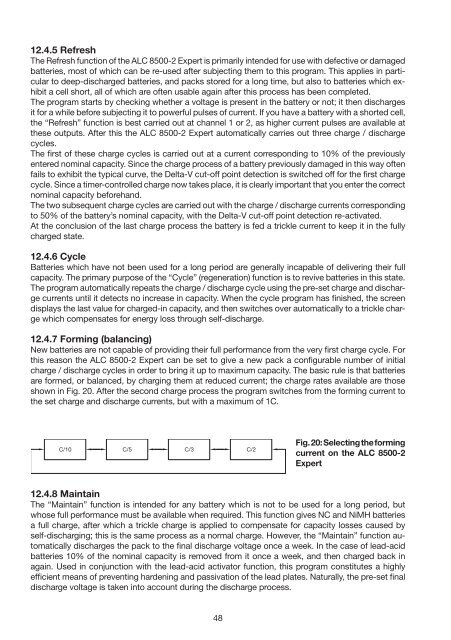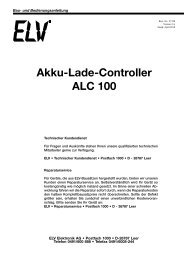Akku-Lade-Center Battery Charging Centre ALC 8500-2 ... - Batimex
Akku-Lade-Center Battery Charging Centre ALC 8500-2 ... - Batimex
Akku-Lade-Center Battery Charging Centre ALC 8500-2 ... - Batimex
Erfolgreiche ePaper selbst erstellen
Machen Sie aus Ihren PDF Publikationen ein blätterbares Flipbook mit unserer einzigartigen Google optimierten e-Paper Software.
12.4.5 Refresh<br />
The Refresh function of the <strong>ALC</strong> <strong>8500</strong>-2 Expert is primarily intended for use with defective or damaged<br />
batteries, most of which can be re-used after subjecting them to this program. This applies in particular<br />
to deep-discharged batteries, and packs stored for a long time, but also to batteries which exhibit<br />
a cell short, all of which are often usable again after this process has been completed.<br />
The program starts by checking whether a voltage is present in the battery or not; it then discharges<br />
it for a while before subjecting it to powerful pulses of current. If you have a battery with a shorted cell,<br />
the “Refresh” function is best carried out at channel 1 or 2, as higher current pulses are available at<br />
these outputs. After this the <strong>ALC</strong> <strong>8500</strong>-2 Expert automatically carries out three charge / discharge<br />
cycles.<br />
The first of these charge cycles is carried out at a current corresponding to 10% of the previously<br />
entered nominal capacity. Since the charge process of a battery previously damaged in this way often<br />
fails to exhibit the typical curve, the Delta-V cut-off point detection is switched off for the first charge<br />
cycle. Since a timer-controlled charge now takes place, it is clearly important that you enter the correct<br />
nominal capacity beforehand.<br />
The two subsequent charge cycles are carried out with the charge / discharge currents corresponding<br />
to 50% of the battery’s nominal capacity, with the Delta-V cut-off point detection re-activated.<br />
At the conclusion of the last charge process the battery is fed a trickle current to keep it in the fully<br />
charged state.<br />
12.4.6 Cycle<br />
Batteries which have not been used for a long period are generally incapable of delivering their full<br />
capacity. The primary purpose of the “Cycle” (regeneration) function is to revive batteries in this state.<br />
The program automatically repeats the charge / discharge cycle using the pre-set charge and discharge<br />
currents until it detects no increase in capacity. When the cycle program has finished, the screen<br />
displays the last value for charged-in capacity, and then switches over automatically to a trickle charge<br />
which compensates for energy loss through self-discharge.<br />
12.4.7 Forming (balancing)<br />
New batteries are not capable of providing their full performance from the very first charge cycle. For<br />
this reason the <strong>ALC</strong> <strong>8500</strong>-2 Expert can be set to give a new pack a configurable number of initial<br />
charge / discharge cycles in order to bring it up to maximum capacity. The basic rule is that batteries<br />
are formed, or balanced, by charging them at reduced current; the charge rates available are those<br />
shown in Fig. 20. After the second charge process the program switches from the forming current to<br />
the set charge and discharge currents, but with a maximum of 1C.<br />
C/10 C/5 C/3 C/2<br />
Fig. 20: Selecting the forming<br />
current on the <strong>ALC</strong> <strong>8500</strong>-2<br />
Expert<br />
12.4.8 Maintain<br />
The “Maintain” function is intended for any battery which is not to be used for a long period, but<br />
whose full performance must be available when required. This function gives NC and NiMH batteries<br />
a full charge, after which a trickle charge is applied to compensate for capacity losses caused by<br />
self-discharging; this is the same process as a normal charge. However, the “Maintain” function automatically<br />
discharges the pack to the final discharge voltage once a week. In the case of lead-acid<br />
batteries 10% of the nominal capacity is removed from it once a week, and then charged back in<br />
again. Used in conjunction with the lead-acid activator function, this program constitutes a highly<br />
efficient means of preventing hardening and passivation of the lead plates. Naturally, the pre-set final<br />
discharge voltage is taken into account during the discharge process.<br />
48



